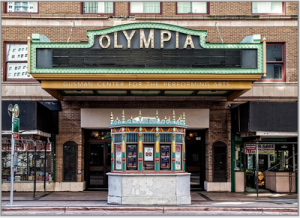A Walk Through The History of the Olympia Theater at Gusman Center for the Performing Arts – Miami, FL
Note: We asked our theatre friends to submit their stories for #historictheatres day; the following is shared by Jeannie Piazza-Zuniga, who began as an Intern from Florida International University and retired as Director of Theater Operation of the theatre. She is a long-time member of the Theatre Historical Society of America. If you’d like more information on her upcoming memoir or the Olympia Theater, you may contact her at jeanniepiazza@Yahoo.com or zunipia@bellsouth.net.
The Olympia Theater at Gusman Center for the Performing Arts is located on the southwest corner of Downtown Miami’s busiest intersection at Flagler Street and 2nd Avenue– the original site of the “Airdome Theatre.” It was built in 1925 by Paramount Enterprises at a cost of $l.5 million.
John Eberson, was selected by Paramount as the architect. Eberson departed from the usual theater-style building and created the first of many “atmospheric” theaters with turrets and towers in Spanish style. It was the most beautiful and elaborately equipped theater of its time and believed to be the first air-conditioned theater in the South. It has maintained its reputation as an acoustically perfect theater and remains the love of many Miamians.
In 1929 the excitement of a twenty-five year presentation of stars gracing the stage at the Olympia began: Sophie Tucker, Joe E. Brown, Martha Raye, Rudy Vallee, Burt Wheeler, Jackie Gleason and even Elvis Presley. Motion pictures were introduced in 1954 and were presented until 1971, when the theater’s doors closed.
In 1970, the theater was purchased by Miami philanthropist, Maurice Gusman, for housing the Miami Philharmonic Orchestra. Renovations totaling $5 million were completed under the watchful eye of Miami Beach architect, Morris Lapidus. The Olympia Theater was renamed and reopened October 21, 1972 with a symphonic tribute to Maurice Gusman. Included on the program for that evening was Beethoven’s Ninth Symphony to which the audience thrilled in the acoustically perfect theater.
In 1975, Gusman, now in his late 80’s, gifted the theater to the City of Miami, with the stipulation that the Center be managed by the Department of Off Street Parking, a semi-autonomous agency of the City of Miami. The long-term friendship of Gusman with Colonel Mitchell Wolfson, the Board Chairman of the agency was the basis for this unique arrangement.
In 1977, the mighty Wurlitzer Organ, after 28 years of silence, was restored and played. It is the only originally installed pipe organ south of Atlanta housed in its original theater. It took 7 years and 100,000 volunteer hours to repair the 1,035 pipes of the great Wurlitzer. It continues to be maintained through loving donations to the South Florida Theatre Organ Society.
In 1985, a replica of the theater’s original ticket booth was completed. Only the air-conditioning and computerization does not hold true to the original 1925 booth; otherwise, it is exact. During that same year, the Olympia at Gusman Center was registered and became a theater on the National Historic Register. It plays a pivotal role in South Florida’s cultural community.
From 1983 through 2001, The Olympia Theater at Gusman Center became a treasure to the hub of Downtown Miami Cultural excitement. The Sensational Programs brought stars on stage again and the audiences flocked to the theater to see a new generation of stars, such as Chuck Mangione, Dr. Billie Taylor, Ramsey Lewis, Nancy Wilson, Lou Rawls, Herbie Hancock, Nestor Torres, Shadowfax, Ottmar Liebert, Luciano Pavarotti, Joan Sutherland, outstanding concert orchestras, and so many others. The stars where shining on the Olympia Stage again.
It became a birthing place for the Miami City Ballet with Edward Villella as Artistic Director; The Florida Philharmonic Orchestra with James Judd, and the New World Symphony, a training orchestra recognized worldwide for its excellence under the baton of Michael Tilson Thomas. The Miami Film Festival, “For the Love of Film” under the direction of Nat Chadiak, presented outstanding US and foreign films. Additionally, over 160 new cultural organizations help to bring millions of people through the doors at the Olympia. The marque lit up downtown for almost 20 years.
On 2001, September 11, darkness fell over our nation as New York’s Twin Towers were hit by 2 planes flown by terrorists in an unbelievable attack. Everyone struggled to stay strong, as did our beloved Olympia Theater. Entertainment was difficult in the aftermath of such terror. The Olympia struggled as best it could, but the brilliance of the 20’s, 80’s and 90’s dimmed.
In 2017, natural disasters throughout our country and the world seemed to place a blanket over the many classic movie palaces. They sleep for now but they will return because there is love inside each theater and there are people who believe that these theaters speak of the history of not only each theater but the universal culture of our world and its architectural endearment.
The future: Unknown….However….
During the year 2025, The Olympia Theater will celebrate its 100th Birthday. Join Our Celebration. I will be celebrating.
If you find this story fascinating, we have a treasure trove of information about the history of your favorite theatres. Sign up for an account on historictheatres.org and enter through the STAGE DOOR!
For nearly fifty years Theatre Historical Society of America has been celebrating, documenting, and promoting the architectural, cultural, and social relevance of America’s historic theaters. However, we can’t do it alone. Support from cinema lovers, architects, historians and people like you are paramount to our success. Become a member today, and help us preserve the rich history of America’s greatest theatres.






 Previous Post
Previous Post